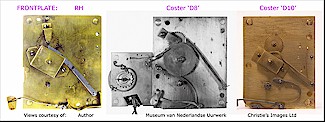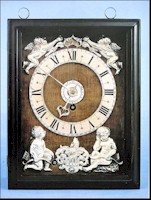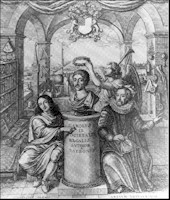 |
A Royal
'HAAGSE KLOK'
by: Keith Piggott. |
 |
|
|
 APPENDIX
3
Back to Main Document. APPENDIX
3
Back to Main Document. |
| |
|
●
Open Research Project on Early Pendulum Clocks. |
|
|
Researchers will now be able to add to present knowledge, by
comparing images and dimensions of the subject Oosterwijck with Coster’s known
Hague clocks, also with comparable European pendulum clocks. I recommend the
following pointers to horologists and researchers, as being probably rewarding
new lines of enquiry.
Salomon Coster’s pendulums fall into the earliest phase of Hague clocks. His
known pendulum timeline is from his June 16th 1657 Patent, assigned to him by
Huygens for 21 years, to his decease in December 1660. Of course he had to be
involved even earlier in Huygens’ initial trials and preparing Patent
Applications.
In Coster’s pendulum oeuvre, time-pieces having ‘square’ pillars are regarded as
the earliest of his few extant clocks. all being attributed to John Fromanteel
under his Contract with Coster on September 3rd 1657. Clocks having ‘round’
pillars are thought to be later. As a consequence of this rather uncertain
methods of dating, Dr.Plomp’s chronology puts Coster’s earliest extant timepiece
D1 bearing scratched date 1657, among his post-Contract Oeuvre. Whereas,
Huygens' earliest drawing of his 1657 weight regulator, (I assign it reference,
'DØ1W'), shows baluster pillars.

fig. OR1 (click to enlarge)
The Box Cases of the 'Royal' and three Coster Hague Clocks.
Extant timepieces, alarums and striking clocks, attributed to Coster, all have
four-wheel trains; all have plain unsigned movements; all have four pillars, all
riveted to the front plate and pinned at the back plate. All his single and
split-barrels are front wound. All have round dial-feet, except D5 (square), D8
(hexagonal). Timepieces have set-up ratchets mounted on front plates, his Alarum
'D5' has the ratchet on the backplate, whereas his striking clocks have internal
set-up ratchets now on the front barrel cap (like Oosterwijck's). Coster’s
‘going’ trains all have the first wheel planted behind the barrel; centre
pinions fix centre wheels; all have vertical trains to the 3-spoked contrate and
verge-escape wheels; all have short verge-staffs held in Dutch block-potences;
and naturally, all had Huygens’ patent crutched-verge with his suspended
pendulum and cheeks (several are reconstructed).

Immediately one questions, why did Oosterwijck plant his centre-wheel at the
front? And why did Pierre Saude too, in 1659, when Coster purportedly had set
the only model used by the French makers? (see “Huygens Legacy”, Nr.14,
pp.40-41).
Why the paucity of extant pendulums made by Coster himself? Coster? 'D3', found
incomplete in France, by Gerd Wijnen, has an unconventional barrel cap, fitted
into its barrel by a curious dovetail; it then had a tear-drop pierced,
sculpted, hour hand of an earlier type. Berry Van Lieshout suggests this method
of fixing the barrel cap might relate to Coster’s apprenticeship using
Renaissance techniques. Privately, he suggests it could well be the only true
‘Coster-Coster’ pendulum extant. Yet its square pillars place it, too, within
the Contract period, as that single feature is attributed solely to John
Fromanteel. Less obvious autograph features are being ignored; we must identify
and qualify all these too.

Fromanteel’s signed and dated 1658 timepiece looks like Coster’s. However, its
six square pillars are riveted to a taller back plate, pinned at the front; its
set-up ratchet is on the back plate; its watch-stop work is on the going barrel
at the front cap, having a five-wheel train, planted vertically, with an
intermediate wheel (for longer duration) fixed to its arbor by a pinion at the
back plate (like Coster centre-wheels), with its centre wheel reversed to the
front plate, to the now rebuilt Dutch potence block; having Huygens’ horizontal
escapement and his suspended pendulum.

Bartram’s little clock c.1659, has four tapered square pillars, pinned at the
back plate, now with two five wheel trains; the centre wheel at front plate;
having two back-wound going-barrels in place of a split-barrel, each has
diminutive watch-stop work set on the winding squares at the back plate; now
with a pivoted pendulum (but signs of a Dutch escapement). His going wheels all
have three spokes, typical of the Hague clocks. [Bartram’s relationship
with Fromanteel is presumed; Livery Company records show that in 1655 Simon
Bartram, Thomas Loomes and John Fromanteel were all Sureties to Ahasuerus
Fromanteel; this probably refers to the younger son, (apprenticed to Lionel Wyth
on 21 June 1654, whom Bartram had taken over during his apprenticeship), who was
made Freeman on 6th July 1663].
Edward East made several early spring-driven wall clocks with beautiful large
dials, all-over florally engraved in his goldsmith trained free style, all
having Fromanteel's pivoted pendulum, a single hand, some with alarum, and all
having the strike on a second barrel. One movement was exhibited at Octrooi op
de Tijd, nr.40, (Museum Boerhaave, 1979; reproduced in Early English Clocks,
plates 104-107). Originally it would have had an ebony Tabernacle case, like his
'Huddleston' clock (Lloyd, H A, 'Old Clocks'. plate 15c). East also made a small
box-cased timepiece, having early four-wheel train, now restored with verge
across the plates to a pivoted pendulum in the manner of Fromanteel. Its centre
wheel is at the front plate, its ratchets too. The signed backblate inscribed
with a spurious date 1763. East's bold baluster pillars are unlike other London
or Hague pendulum clocks, but are seen in Bernard van Stryp's contemporary
Antwerp clock. East's going-barrel extends in four protruding lugs, with holes
by which the front cap is pinned. It is unconventional, but also seen on the
anonymous nodding-Chronos posted clock, (formerly Ilbert’s, now in the British
Museum), which -on other grounds- I have likened to Davis Mell’s musical
automaton chamber clock, I have attributed both those clocks to Ahasuerus
Fromanteel Senior.
Are these Fromanteel, Bartram and East pendulum movements just the distant
English cousins, or the natural brothers, of the Royal Oosterwijck?
What is certain but is usually overlooked, in 1657 and later, any English
pendulum construction that mirrored the Dutch spring clock format, whether made
by the Fromanteels, Bartram or East, had to be derived directly from an actual
Coster clock in hand, i.e., not from Huygens’ intentionally diverting "OP"
drawing of a half-seconds weight clock that he published first in “Horologium”,
(September 1658). Huygens' original seconds' weight clock, presented in Coster's
June 1657 Patent, was not published until "Horologium Oscillatorium" in 1673.
Severijn Oosterwijck's Royal clock proves that, during 1657-8, he was close to
Salomon Coster and John Fromanteel then in Coster’s employ, as well as having
Huygens' confidence. The fact that his clock bears his own signature indicates
he nevertheless remained independent and had his own clientelle. We also know,
in May 1660, Alexander Bruce (Earl of Kincardine) joined Charles II in The Hague
for His triumphant return into England. It is likely that Huygens' new pendulum
clocks figured in their discourses, leading to their contacts with Huygens and
Oosterwijck, also arousing Bruce's subsequent interest in the pendulum's,
supposed, Longitude applications, which he independently was to pursue on his
return to London; very probably using the Fromanteels to develop his "F" forked
crutch which he first showed to Huygens in London during 1661.
However, we do not know when Severijn first had contact with the Fromanteels'
workshop in London. Did he, like John Hilderson and the Roussels, make that
short sea crossing somewhat earlier? If he did not, then similarities between
his clock and Fromanteel’s early practices are even more remarkable. However, if
he did have earlier contact, that might resolve the secret of the September 3rd
1657 Contract, between young John Fromanteel and prosperous Salomon Coster – who
curiously pledged his entire, present and future, wealth to meet its arcane
terms.
A catalogue raisonne´ of Severijn Oosterwijck’s Oeuvre would be invaluable.
Several are identified by Dr.Plomp, Mr.Vehmeyer, and “Huygens’ Legacy". The
“Lieberge” silver-mounted timepiece-alarum is another of Severijn’s early gems,
ascribed to 1658-1662, it sets new heights in precious ostentation.

Fig. 3a1 (click to enlarge)
Oosterwijck's exquiste, silver-mounted, 'Lieberge' Hague clock. (Images courtesy
of Sothebys Amsterdam).

Lieberge's cheek cocks are like the subject clock, but its
reversed verge-cock resembles Coster's. It is an early example of a Hague clock
being signed on the backplate, and it introduces his trademark plate outlines.
(Sotheby’s Amsterdam, 21-02-1995, Lot.324). Two later Oosterwijck clocks, one
also signed on the backplate, are depicted by Dr.Plomp, ("Pendulums", Op.Cit.
nrs.84, 85).
|
|
|
|
Links to
Open Research matrices on early pendulum clocks:
●
Go to 'spring driven' clocks.
●
Go to 'weight driven' clocks.
|
 |
|
There is so much to be learned, so much evidence to be revisited, the task
should impassion new researchers to take up the mantle from we gracefully
ageing enthusiasts. To start the
ball rolling, I offer an open research Matrix in the Horological
Foundation’s court.
|
|
| Click
here to contribute to the project |
|
|
More
project documents:
●
Memorandum D4
(Courtesy Science Museum)
|
|
|
It was not usual for the earliest Dutch pendulum clocks to have signed
backplates; however it may now be assumed that Oosterwijck did by 1662. (I
discount the dated dedication on one regulator). Brigadier Meyrick Neilson of
Tetbury once had an Oosterwijck table clock, having an English dialplate and
olivewood case, having an offset-winder for a fusee, signed 'Severyn Oosterwyck
Hague' on the wedge-shaped backplate. Leopold and Weston made a connection with
the longitude experiments, (Weston, A.,"A Reassessment of the Clocks of John
Hilderson", Antiquarian Horology, Vol.24, Nr.4, pp.407-432, June 2000, AHS).
Probably it is the earliest Hague clock to have a fusee*, being good evidence of
the London origin of Bruce's original sea-clock he showed Huygens in 1661. The
seven-inch pendulum (Huygens says 9 inches) oscillated at around 142
beats/minute, a peculiar number if he intended to show Seconds'. Its rear dial
indicates 4-minutes, being 1 degree of latitude, but not yet
understood. Pilot-mariner Brian Walton points out, the Babylonian astronomers
divided 24 unequal hours by 360 degrees, using the product 4 minutes "Ush" as a
unit to calculate eclipses. He also notes, 4-minutes is the sidereal variation
with the mean day - (mean time variation is 3m 59s); useful for taking star
sightings without needing solar equation tables. On land, sideral time might
also be used to rate the timepiece, or to take star sightings to fix longitude
at ports of departure. I have enlightened the extant clock's custodian. [* I do
not discount Coster's earlier use of Fusee in his early pendulum oeuvre; a hard
habit to break].
Early pendulum Longitude Clocks, the first by Scotland's Alexander Bruce, then
by Holland's Christiaan Huygens, involved Severijn Osterwijck directly, from
1662 to 1664. Longitude timekeeping was of huge import, but little is known of
the actual clocks. As I have postulated before, and repeated herein above, I
suspect that Simon Douw of Rotterdam intended his patented 1658 clock for Marine
Longitude, for which its spring remontoir and beam-oscillator (crossbeat?) were
ideally suited; a paradigm that Huygens did not then appreciate, neither in
mischevious 1658 litigation, nor in wasted years using pendulums and weight
remontoirs – to Robert Hooke’s amusement and lecture note animadversions, (see
British Museum MSS -Sloane 1039, folio 129). During contested litigation in
1658, Douw very wisely kept counsel about any intended maritime application -
for his home port of Rotterdam - he died in Sept.1663.
Like Weston, I draw attention to the frontispiece to Thomas Spratt’s ‘History of
the Royal Society of London’ (1667), engraved by Wenceslaus Hollar to John
Evelyn’s design, depicting the founding of the Royal Society which had been
mooted by Sir Robert Moray. Horological items include, probably Bruce's
Longitude Clock, also a curious Tall Clock, possiby the Bishop of Exeter
Dr.Ward's 'Lawrence Rooke' commemorative clock by Ahasuerus Fromanteel in 1662-3
given to the fledgling Royal Society.

fig. 3a3 (click to enlarge)
Hollar's 1667 Frontispiece to Spratt's 'History of the Royal Society'.
A garlanded bust of King Charles II stands upon a pedestal
between Viscount William Brouncker, the first president, and Francis Bacon,
Viscount St.Alban, surrounded by the regalia also its members’ scientific
accoutrements. Of interest, and confirming Hollar's attention to detail, is
Robert Hooke's pole-telescope, Robert Boyle’s famous Torricellian apparatus,
also a small triangular clock hanging from the wall, apparently on Cardan’s
suspension.
Hooke's telescope is also a reminder of Lawrence Rooke (1622-1662) who had
championed Longitude timekeeping, but by the Lunar Observation method treating
the moon's irregular surface as gnomons on a sundial, (to compare a first
magnitude star's altitude against a known origin at the same time), Charles II
was his convert. (see Lomas, Dr.Robert, "Sir Robert Moray,
Soldier,Scientist,Spy,Freemason and Founder of The Royal Society", Gresham
Lecture, 4th April, 2007). Rooke's untimely death, perhaps, was fortuitous for
the better advancement of determining Longitude by mechanical clocks. The
conflict of these two opposed schools of thought persisted lhrough the 18th
century, even setting astronomer Maskelyne against Harrison who won.
The triangular clock in Hollar's print, probably, is Alexander Bruce’s first
Longitude clock he showed to Christiaan Huygens in London in 1661. It raises the
vexed question, "Who made it for Bruce?"
Whilst in the Hague, from March to December 1662, Bruce had two similar clocks
made by Severijn Oosterwijck*; antedating Huygens’ own rectangular weight-driven
Longitude designs with weight remontoirs. During Bruce's return voyage to
England one of his Oosterwijck clocks was badly damaged, John Hilderson in
London was engaged to make a copy, which was used in Capt. Holmes' subsequent
voyage to The Gambia in 1663-1664. [* Leopold, J.H., ‘The Longitude
Timekeepers of Christiaan Huygens’, (‘The Quest for Longitude’, p.104, n.21,
edited by William J H Andrews, Harvard 1997)]. As a result of this paper, might
one of Oosterwijck's Longitude-clocks be found?
Of note, too, Hollar's print also depicts a Palladian window balcony, with a
curious tall case clock having a small square dial surmounted by a pyramid
obelisk, unlike any surviving English clock. Might this represent Dr Ward’s
"large pendulum clock" of Birch's 1756 history, the one made by Fromanteel?
Without its obelisk, it would resemble Fromanteel's long duration Kingwood
longcase clock now in the British Museum; its position, as shown, would also
resolve the rear-doors to the trunk of that clock. (see Dawson,Drover,Parkes,
’Early English Clocks’, Chap.XI, p.501 and pl.742-743, ACC 1982). If the clock
shown had a long-pendulum, probably it had Huygens' OP gear with a vertical
escapement, and beat seconds and a quarter, or longer; already long used by
astronomers; when its extra-long pendulum might be suspended above the movement
at the obelisk’s apex, the pendulum bob oscillating within the plinth, impulsed
by an extended crutch, (like later Zaanse and Friesland clocks).
Christiaan Huygens' well known early drawings of sea clocks, inspired by
Bruce's, but having his later patented weight remontoir, are depicted as weight
clocks; whereas the spring barrel with fusee had to be the preferred motive
power - as Robert Hooke and Ahasuerus Fromanteel realised. Was it then
Fromanteel who had made Bruce's prototype, to Hooke's specification? Was Huygens
disingenuous, again, in depicting his trial Longitude clock on a weight, simply
to divert potential competitors?
Huygens' declared "nine-inch pendulum" would not indicate Seconds' directly, but
his first remontoire sketch, at Leiden, shows a four-wheel train having a
Seconds' hand, the Greatwheel (120), the Centre (8/96), the Third (6/80), the
vertical Escape shown as "6/min" (sketch shows 8 escape teeth visible, 17 teeth
would give 120.89 beats). Huygens' train in no way resembles the
Oosterwijck-Bruce Longitude fusee movement which I am presently constrained from
publishing. By such fugitive clues we advance our knowledge of this vibrant
horological period.

Fig. 3a4
(click to enlarge)
Huygens' first sketch of his Longitude clock and weight remontoir. (Huygens'
Oeuvres, MS Aug-Sep 1662, Acknowledment to University of Leiden).
After conducting this unexpectedly consuming and even
self-indulgent review, the subject rewards itself, I now suspect that
Oosterwijck’s prior involvement with the Fromanteels is not unlikely. But,
having once crossed swords with ‘professional’ antiquarians that led to an
invitation from the Horological Foundation and my first published paper in 2005,
here I shall let loose the reins, in the hope of widening the pool of
enthusiasts who will delve into the still murky waters of the early pendulum
story, then contribute their knowledge. Historians and researchers are not
helped by possessiveness of some custodians who should realise the merit in
'open research' to assemble the facts that may determine evolutions and
chronologies, ultimately to benefit scholarship. I commend the example of Museum
van het Nederlandse Uurwerk (Museum of the Dutch Clock), who alone keep records
of trains and are most helpful to any research.
There is so much to be re-learned, and so much evidence to be re-visited, the
task should impassion new researchers to take up the mantle from we gracefully
ageing enthusiasts. To start the ball rolling I offer a simplified version of an
open research matrix being assembled on the Horological Foundation website. I
recommend it to all.
|
|
COMPARISON
TABLE
Click
here to see data of this clock and other early pendulum clocks in the 'Open
Research'
comparison table.
|
|
|
 Copyright:
R.K.Piggott,
February 20, 2009. Copyright:
R.K.Piggott,
February 20, 2009. |
|